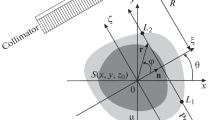Summary
Computed tomography, employing an EMI scanner at two beam energies, can be used to obtain information about the electron density and the effective atomic number of materials. The theory which is discussed has been verified experimentally and then applied in the investigation of some brain tumours in vivo. It is anticipated that, as techniques improve, the ability to carry out chemical and physical analysis of pathological processes in vivo will be an important application of computed tomography.
Similar content being viewed by others
References
Rutherford, R. A., Pullan, B. R., Isherwood, I.: Calibration and response of an EMI scanner. Neuroradiology 11, 7–13 (1976)
Veigele, W. J.: Photon cross-sections from 0.1 ke V to 1 Me V for elements Z=1 to Z=94. Atomic Data Tables 5, 51–111 (1973)
Spiers, F. W.: Effective atomic number and energy absorption in tissues. Brit. J. Radiol. 19, 52–63 (1946)
Weber, J., van den Berge, D. J.: The effective atomic number and the calculation of the composition of phantom material. Brit. J. Radiol. 42, 378–383 (1969)
Author information
Authors and Affiliations
Rights and permissions
About this article
Cite this article
Rutherford, R.A., Pullan, B.R. & Isherwood, I. Measurement of effective atomic number and electron density using an EMI scanner. Neuroradiology 11, 15–21 (1976). https://doi.org/10.1007/BF00327253
Received:
Issue Date:
DOI: https://doi.org/10.1007/BF00327253




